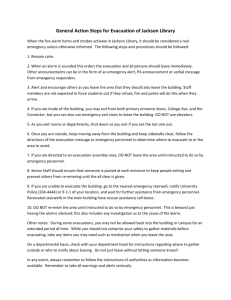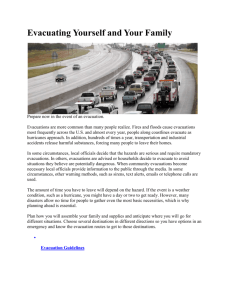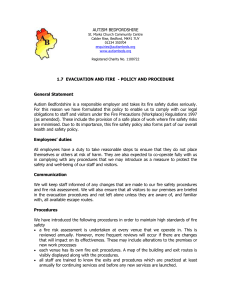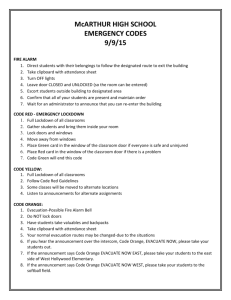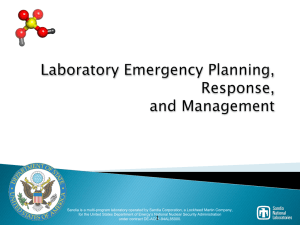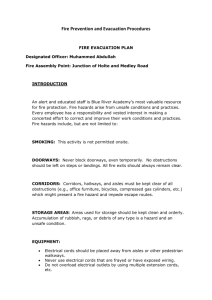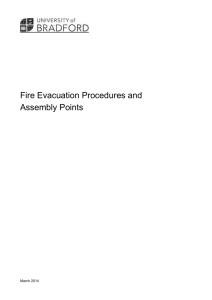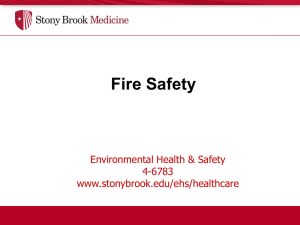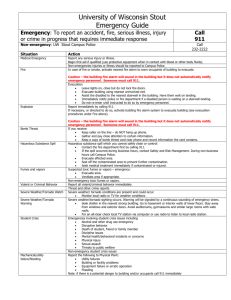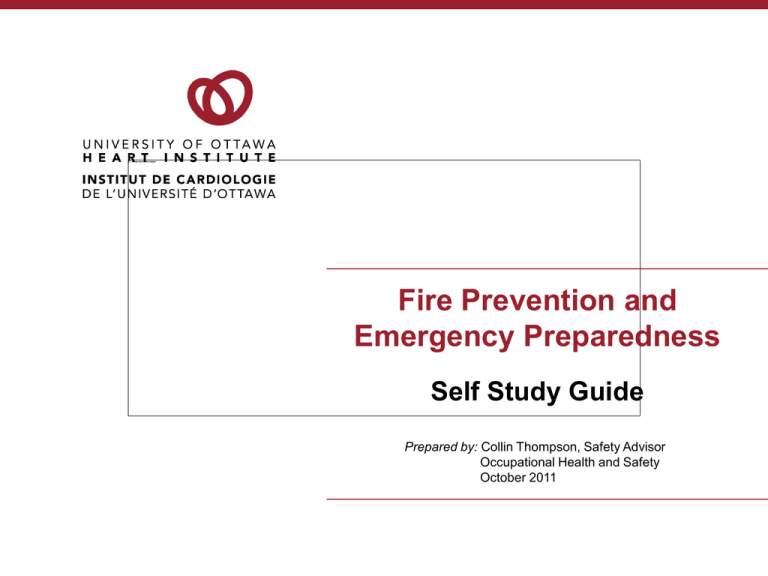
Fire Prevention and
Emergency Preparedness
Self Study Guide
Prepared by: Collin Thompson, Safety Advisor
Occupational Health and Safety
October 2011
INTRODUCTION AND PURPOSE
INTRODUCTION
The potential for internal emergency situations such as fire or hazardous
material spills exist in most workplaces.
The Heart Institute recognizes that all its employees require training in
order to enable them to respond appropriately in a fire or spill situation to
protect themselves and preserve the safety of patients, colleagues and
visitors.
PURPOSE
The purpose of the module is to provide employees with an awareness of
the procedures in place in this institute to deal with emergency situations,
internal or external to the institute, as they may occur.
All major types of Emergencies
are categorized by a colour
code
North American System
EMERGENCY INFORMATION
BOOKLET & MANUAL
Additional detailed information regarding procedures in place for emergency situations
can be found in the University of Ottawa Heart Institute Emergency Information Booklet
and Emergency Procedures Manual.
FIRE SAFETY PROTOCOL
FIRE PREVENTION PROGRAM
• The primary goal is the preservation of
LIFE through timely intervention.
• The secondary goal is reducing the risk to
Hospital Property.
– Achieving this goal actually helps in
achieving the first goal.
THE THREE METHODS TO ACHIEVING
OUR GOAL
Education
Awareness
Active Participation
EDUCATION
Fire Prevention & Code
Lectures are mandatory
for all employees.
Code RED
Code Brown
Code Orange
AWARENESS
INFOWEB – Health and Safety Site
OHS Boards
Flyers & Pamphlets
Colleagues
Events (Safety & Emergency Preparedness
Week)
ACTIVE PARTICIPATION
•
All staff must actively participate in fire drills, code
exercises and conduct a review of the fire manual
and emergency procedures manual on an annual
basis.
•
All staff must be fully aware of their work area and
the building.
•
All staff must learn their exit travel. Know where
exit stairs lead to.
Know the location of fire emergency equipment
and fire alarm pull stations.
Safety is Everyone's Responsibility!
CODE RED - Defining a Fire
Situation
• A fire situation is defined as visible fire or smoke.
• It makes no difference what size or what amount of
smoke is present.
• Either case constitutes a fire situation and requires
following the protocol for reporting a fire.
Reporting a Fire
Using the FIRE ALARM SYSTEM
In the Hospital setting we use the word
“S.C.A.T.E.”
The sequence in which you use the letters is not
important. It matters only that the sequence is
completed for everyone's safety. Safety meaning your
safety, your fellow workers, patients and visitors.
Every second counts and could potentially save lives!
How to Report a Fire & When To
Use The FIRE ALARM SYSTEM
S.
C.
Save the patients - remove patients, colleagues and visitors into corridor.
Close door to contain fire, smoke and hot gases in room. Place a wet
blanket at bottom of door to keep smoke and hot gases in room.
A.
Alarm - sound the fire alarm located by all exit doors and most
Nursing Stations.
T.
Telephone the Emergency Number - 1-5555
E.
Evacuate or Extinguish - The Ottawa Fire Department prefers
that we evacuate our patients and allow them to extinguish the
fire. Always move towards an exit and remember the air is
freshest by the floor in a smoky environment, so stay low.
Know the Location Of Your Fire
Equipment
Pull Stations
Located near exit doors, stairwells and by elevators.
Portable Fire Equipment
Hose cabinet and fire extinguishers located in the corridor.
THE HOSPITAL FIRE ALARM SYSTEM
FIRST STAGE:
Once the fire alarm pull station has been activated, the first stage rings at 60
strokes per minute continuously until the alarm is acknowledged.
Switchboard announces a CODE RED and the location.
SECOND STAGE:
Upon investigation, if deemed necessary, a key is inserted into the fire alarm
pull station upgrading the alarm to the second stage which rings at 120
strokes per minute and will not shut-off.
This indicates that an area of the Hospital or the entire Hospital is about to
be evacuated.
Switchboard announces a CODE GREEN”and we direct the evacuation.
CODE GREEN - EVACUATION
PROCEDURES
Two types of evacuations:
Horizontal and Vertical
Horizontal is always the first choice of
movement because it is the easiest method of
relocating patients/visitors from an area of
danger to an area of safety.
HORIZONTAL EVACUATIONS
VERTICAL EVACUATIONS
Vertical evacuations are only used as a last resort.
• A partial vertical evacuation in conjunction with a
horizontal evacuation.
• Down two floors and then into the lower floor
compartment.
Complete vertical hospital evacuation:
• Only the CEO, Admin. On-Call or the City of Ottawa
Fire Chief has the authority to order a total Hospital
Evacuation.
SATELLITE RELOCATION CENTERS
During a full evacuation the Heart Institute will evacuate to
the following location:
Heart Institute: will evacuate to The Ottawa Hospital - Civic
Campus (For any emergency that effects the Heart Institute
but not TOH)
OR
Heart Institute: will evacuate to Fisher Park Public School
(For any emergency that involves the evacuation of both the
Heart Institute and TOH (Civic Campus)
EVACUATION PRIORITIES
Priority One
All ambulatory patients are led down the stairs to the assembly area. One
staff member is placed in charge of this group.
Priority Two
Semi-ambulatory patients are assisted down the stairs. These patients can
sit on the stairs and help themselves down. One staff member is placed in
front and one staff member at the back so this group is constantly monitored
and assistance can be given whenever necessary.
Priority Three
These patients are moved using lifts and carries. Patient (non-ambulatory)
are further categorized according to their degree of difficulty to move, such
as CCU, CSICU, COR.
Under certain conditions the FIREFIGHTERS’ ELEVATORS will be used.
PATIENT CLASSIFICATION
A. Able to be discharged home with minimal risk.
B. Able to be discharged home with assistance.
C. Able to be discharged to alternate health care
facility.
D. Discharged except in extreme necessity, requiring
life-support.
CLASSES OF FIRE
CLASS “A”
• Fires involving ordinary combustibles such as paper,
wood, rags, etc.
• Use a fire extinguisher with class A rating when fighting
this class of fire.
CLASS “B”
• Fires involving flammable and combustible liquid such
as gas, varsol, grease, etc.
• Use a fire extinguisher with class B when fighting this
class of fire.
CLASS “C”
• Fires involving energized electrical equipment, such as
fuse boxes, transformers, electric kettles, etc.
• Use a fire extinguisher with class C rating when fighting
this class of fire.
CLASSES OF FIRE
Class A,B,C
Fire Extinguisher to be used in
Mechanical spaces and Electrical
vaults.
FIRE EXTINGUISHER “P.A.S.S.”
PULL
THE PIN
AIM AT THE BASE OF THE FIRE
SQUEEZE THE HANDLE
SWEEP USE A SWEEPING MOTION
FIRE PREVENTION PRACTICES
The most effective way to fight a fire is to prevent it from
happening in the first place. To this end all employees
must be aware of and practice the following guidelines:
• Make sure that there is nothing blocking fire hose
cabinets, fire extinguishers and electrical panels.
• Keep corridors free of obstruction.
• Maintain clear path of egress at all times (42 inches).
• Make sure that exit signs are lit and the exits are not
blocked.
• No combustibles are allowed to be stored in a
stairwell.
• All fire doors in hallways and stairwells shall close
and latch.
FIRE PREVENTION PRACTICES
• Never under any circumstance use wedges or devices to
hold open doors.
• No storage within 18 inches of the ceiling or fire sprinkler.
• No electrical extension cords are allowed to be used as
permanent wiring.
• No appliances (kettle, microwave, fridge etc.) shall be
plugged into power bars or extension cords.
• Power bars shall not be plugged into power bars. Power
bars are fine for items that don’t use much electricity,
such as computers, desk lamps, and cell phone chargers.
• Kettles and coffee makers that don’t have an automatic
shut-off are not allowed in UOHI. Toaster ovens are not
allowed as well.
A POINT TO PONDER
A SAFE AND FIRE FREE WORKING
ENVIRONMENT FOR EVERYONE
The fire and life safety precautions reviewed in
this presentation can be taught.
However, only you can practice the preventive
measures, and by working together as a team,
we can achieve our goal:
CODE ORANGE - Disaster Planning
Code Orange (Disaster) - 15555
Internal Disaster
Fire / Flood / Utility failure
External Disaster
Plane crash / Tornado / Chemical leak into
environment
* Major or Minor Disaster
CODE BROWN – Spills Control
Major or Minor Spills
Minor Spill – Threshold Level, < 1 L
• Generator to clean up
• Emergency Hazmat Spill Cart
Major Spill – Threshold Level, > 1 L
• Telephone the Emergency number - 12999
• Code Brown Assessment Team will respond to assist
with clean-up
• If the hospital team cannot safely control and clean-up,
appropriate arrangements will be made for an external
spill response team (Ottawa Fire Department or HazMat
Contractor)
CODE BLACK – Bomb Threat
• Bomb threats can come from a variety of sources,
although most common is the telephone call bomb
threat
• The action that you take will directly impact upon the
Hospital’s response to the threat
• Treat all threats seriously
CODE BLACK –
Key Questions to Ask
• Where is the Bomb?
• When will it explode?
• What does it look like?
• What will make it explode?
• Why was it put there?
CODE YELLOW – Missing Patient
Three Stages
First Stage:
• Patient is discovered missing.
• Unit staff will conduct a complete search of the unit.
• Affected Manager provides to Security a general description.
(age, sex, height, weight, hair colour, clothing of the
individual)
Second Stage:
• Manager determines whether to alert the patient’s family of
his/her missing status.
• Security notifies other affected hospitals/agencies.
• It is then determined whether on duty support staff from
other departments should be re-assigned duties to expand
the search.
CODE YELLOW – Missing Patient
Third Stage:
• If after a reasonable time the patient is not found, it is then
determined, if additional Security and support staff should
be brought in.
• Campus Security Supervisor will then conduct a full-scale
search of all areas.
• Affected Manager will stay with the next-of-kin, should they
decide to come to the hospital.
OTHER EMERGENCIES
•Violent Patient / Code White / 15555
•Cardiac Arrest / Code Blue / 14777
•Code Stemi
SUMMARY
Fire safety and emergency planning procedures in the Heart
Institute work in conjunction with the plans in place at the
Ottawa Hospital. It is important that all employees understand
their role in these plans.
This module was developed to give employees an overview
of the fire safety and emergency planning principles in place
at the Heart Institute.
It is recommended that where possible, all employees attend
the Fire Prevention and Emergency Preparedness lecture
given by Occupational Health and Safety at the Heart
Institute.


